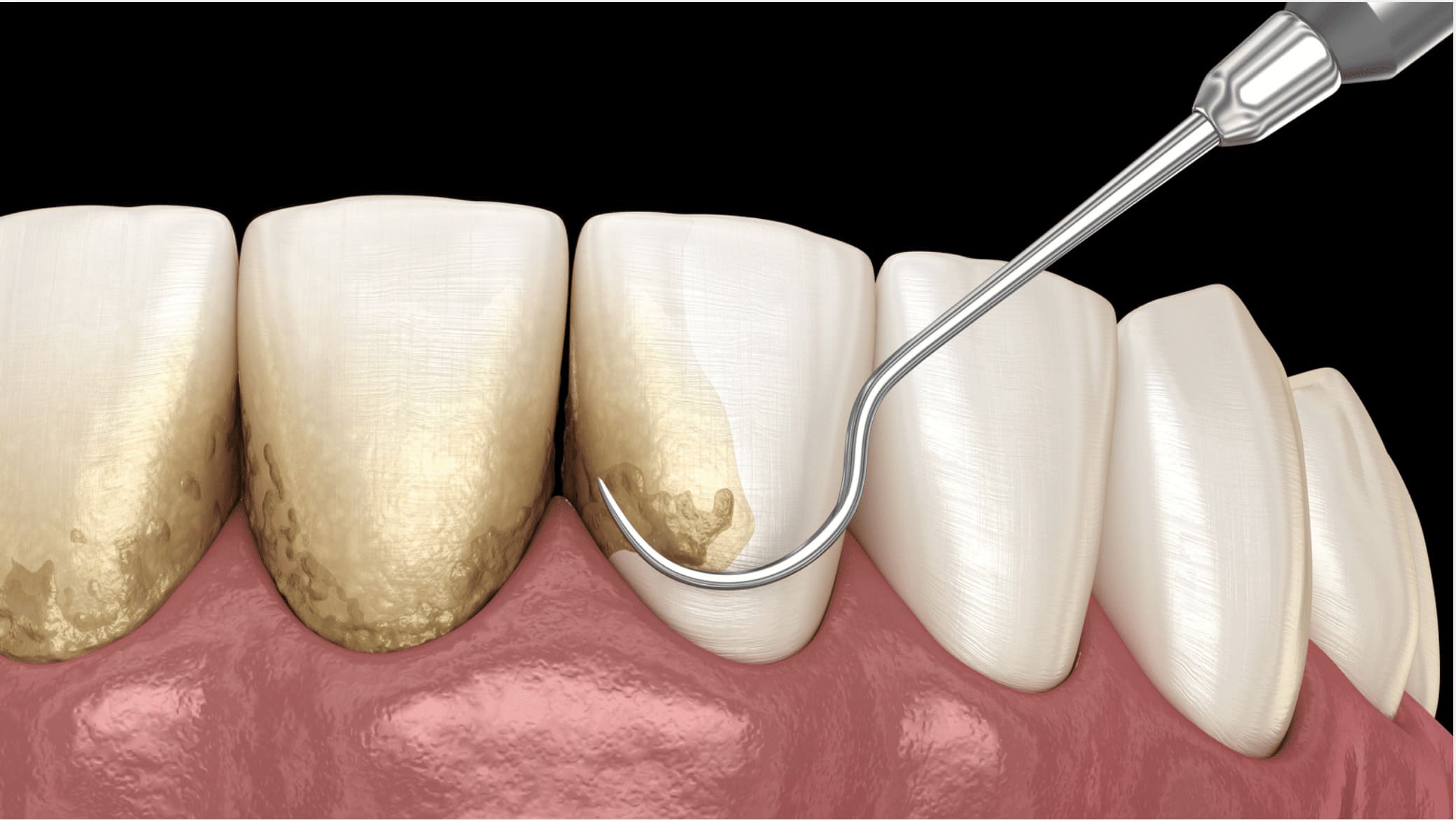Scaling and Root Planing
What is Scaling and Root Planing?
Scaling and rooting planing is a deep cleaning procedure designed to treat gum disease and prevent worsened oral health issues. This treatment involves removing plaque and tartar from above and below the gum line (scaling), then smoothing the tooth roots (root planing) to promote healthy gum reattachment and prevent bacterial buildup.
The primary purpose of scaling and root planing is to address and manage periodontal disease, which can when left untreated, lead to tooth loss. Unlike a typical cleaning, which is conducted as part of your ongoing oral hygiene maintenance schedule, scaling and root planing is a more intensive procedure that aims to treat the deeper layers of the gums and roots. While regular cleaning will focus on removing surface plaque and tartar, scaling teeth involves a deep cleaning below the gum line to eliminate any harmful bacteria and buildup that can lead to gum infections, bleeding, and further damage.
Signs You May Need Scaling and Root Planing
Recognizing the early signs of gum disease is essential for maintaining your oral health and preventing more serious complications, like periodontal disease. If you notice symptoms such as swollen, bleeding, or tender gums, persistent bad breath despite brushing, or gums that are receding or pulling away from your teeth, these may be early warning signs of gum disease.
In its early stages, gum disease can often be managed with simple treatments, but if it’s left untreated, it will progress to more severe stages and potential tooth loss. Periodontal scaling and periodontal deep teeth cleaning are necessary procedures when gum disease has advanced beyond the point where regular cleaning can effectively remove harmful bacteria. These treatments assist in cleaning below the gum line, including smoothing the roots of your teeth to encourage gum reattachment.
Early detection and timely intervention through procedures like scaling and root planing can help you avoid more invasive treatments down the road and protect your long-term oral health. So, if you’re experiencing any of the above symptoms, we recommend consulting with your dentist to determine whether periodontal scaling is needed.
The Procedure Explained
To treat gum disease, periodontal scaling and root planing is a deep cleaning procedure that involves the removal of plaque, tartar, and bacteria from below the gum line. But what is dental root planing? This process involves smoothing the surfaces of the tooth roots to encourage the gums to reattach naturally and prevent further bacterial buildup.
Both procedures involve the following processes:
Initial Consultation and Assessment
During your initial consultation, your dentist will examine your mouth for signs of gum disease, such as bleeding or pockets between your gums and teeth. X-rays may also be taken to assess bone health. If needed, our dentist will recommend scaling teeth to remove plaque and tartar buildup below the gum line, explaining the procedure and benefits to ensure you’re fully informed. This assessment helps create a tailored treatment plan for your oral health.
Step-By-Step Breakdown of the Treatment
- Initial Assessment: Your dentist evaluates your gums and teeth, often using X-rays to check the extent of gum disease.
- Local Anesthesia: To ensure comfort, a local anesthetic is applied to numb the treatment area.
- Scaling: The dentist removes plaque, tartar, and bacteria from below the gum line using specialized tools.
- Root Planing: The tooth roots are smoothed to help the gums reattach and prevent future bacterial buildup.
- Post-Treatment Care: Your dentist provides instructions for aftercare, including any necessary follow-up visits.
This scaling and root planning treatment is essential for managing gum disease and promoting long-term oral health.
Duration and Number of Sessions Required
Scaling and root planning treatment typically takes one to two hours per session, depending on the severity of the gum disease. In some cases, multiple sessions may be required, with each visit focusing on different areas of the mouth. This ensures a thorough cleaning and more effective treatment.
Benefits of Scaling and Root Planing
Periodontal scaling and root planing offers several key benefits for your oral health, particularly when it comes to preventing the progression of gum disease.
Here are some of the main advantages of this treatment:
- Prevention of Tooth Loss: Be removing plaque and tartar buildup below the gum line, periodontal scaling and root planing also helps prevent the advancement of gum disease, which can lead to tooth loss if untreated. Smoothing the tooth roots through dental root planing also reduces bacterial growth and promotes gum reattachment, preserving the ability of your teeth.
- Reduction of Gum Inflammation: Scaling and root planing helps to eliminate the bacteria responsible for inflaming the gums, reducing symptoms such as swelling, bleeding, and tenderness. This leads to healthier, more resilient gums over time.
- Improvement in Overall Oral Health: By addressing the root causes of gum disease, scaling and root planing treatment contributes to better overall oral health, including fresher breath, healthier gums and reduced risk of serious dental complications.
Potential Risks and Considerations
- Temporary Discomfort and Sensitivity: After scaling and root planing treatment, it’s common to experience temporary discomfort or tooth sensitivity as the gums heal and reattach, but this usually subsides within a few days.
- Possible Complications: While rare, possible complications after dental root planing may include prolonged gum sensitivity, infection, or gum recession, but these risks can be minimized with proper aftercare.
- Post-Treatment Care to Minimize Risks: To minimize risks after scaling and root planing treatment, it’s important to follow post-treatment care instructions, including avoiding hard or acidic foods, practicing gentle brushing, and attending any recommended follow-up appointments.
Post-Treatment Care and Maintenance
After periodontal deep teeth cleaning, it’s crucial to support healing and prevent further gum issues by maintaining good oral hygiene. This includes brushing gently with a soft toothbrush, using antimicrobial mouthwash, and flossing carefully. Additionally, your dentist may suggest specific products and schedule follow-up appointments to monitor your progress.
Cost of Scaling and Root Planing
The cost of dental scaling and root planing can vary depending on the severity of your gum disease and the number of sessions required. On average, in British Columbia, the cost for this treatment can range from $200 to $500 per quadrant of the mouth. However, your dentist can provide a detailed estimate in your consultation.
Keep in mind that most dental insurance plans in British Columbia will offer partial coverage, but this is dependent on your specific plan and coverage level. We recommend that you check with your insurance provider(s) to determine your benefits. For those without insurance, we offer flexible payment options. Our team can assist you in exploring the best payment solution to suit your budget.
FAQs on Scaling and Root Planing
1. Is the procedure painful?
The procedure is generally not painful, as local anesthesia is used to numb the treated areas, however, you may still experience some discomfort.
2. How long does recovery take?
Recovery from scaling and root planing treatment typically takes about one to two weeks, with most patients experiencing improved gum health and reduced discomfort within a few days.
3. Can gum disease recur after treatment?
Yes, gum disease can recur after treatment if proper oral hygiene practices are not maintained, so ongoing care and regular dental check-ups are essential for long-term gum health.
4. How often should I have the procedure done?
The frequency of scaling and root planing treatment depends on the severity of your gum disease. That said, the golden rule is every one to three years unless otherwise advised by your dentist.
5. Are there any dietary restrictions post-treatment?
After scaling and root planing treatment, it is recommended that patients avoid hard, crunchy, or spicy foods for a few days, as well as hot or cold beverages that may cause sensitivity in the treated areas.


